14.1: Types of Financing
14.1.1: Financing Life Cycle of the Firm
Firms progress through four stages of a developmental life cycle, each with their own funding needs.
Learning Objective
Identify which type of finance is appropriate for a business based on its stage of development
Key Points
- In the first stage, a new company’s external financing needs (EFN) are high, since it needs money to develop its idea but lacks retained earnings. They are usually financed through debt, but may find investors who are willing to take on risk if projected growth is high.
- In the growth stage, a firm’s initial EFN is high relative to its current value; it needs significant funds for growth. It can be financed through venture capital or issuing equity.
- Growth eventually slows and the firm enters the mature stage. These firms can be financed by equity or debt. If they have no new projects, EFN is relatively low.
- The firm may go into decline as their product becomes obsolete or a competitor outperforms them. In this case, they have very low external financing needs.
Key Terms
- venture capital
-
Money invested in an innovative enterprise in which both the potential for profit and the risk of loss are considerable.
- external financing needs
-
Additional funds needed from sources outside the firm, in order to support firm operations.
- debt
-
Money that the borrowing entity owes or is required to pay to a lender.
Most businesses pass through a series of well defined stages based on their level of development. Churchill and Lewis (1983) identified that all businesses vary greatly in size and potentiality for growth. However, they all experience common problems that arise at similar stages of their development.
From these observations came the four stage life cycle of the firm. Methods of obtaining financial capital may be more or less suitable for a firm, depending on the current stage of its life cycle .
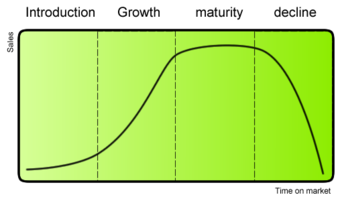
Firm Life Cycle
Firms progress through stages of development, indicated by their changing profits over time.
Introduction
In the first stage, a new company begins with the seed of an idea. Its external financing needs (EFN) are high, since it needs money to develop but lacks retained earnings. These young firms are frequently financed through debt, acquiring loans from banks and acquaintances. They may also acquire seed money, a form of securities offering in which an investor (usually friends, family, or angel investors) purchases part of a business. The source of the financing may depend on the perceived riskiness and growth of the business.
Growth
After the firm is able to acquire external funding and develop its product/service, it enters the growth phase. Once a company has a successful strategy, it attempts to offer its products or services to potential customers–expanding first to other states and regions and then often internationally and globally. Successful companies can turn in increasing earnings year after year, evidenced by the increasingly steep slope in the diagram. Firms may face an increase in competitors. In the growth stage, a firm’s initial EFN is high relative to its current value; it needs significant funds for growth. If it fits the specifications for venture capital (high growth potential, innovative product) a VC firm may agree to finance the firm. It may also raise capital through equity financing. As it progresses through the growth stage, earnings begin to increase less rapidly. At some point, the company may decide to go public, offering its stock to the general public on a security exchange as a means of equity financing.
Maturity
Eventually, all possible customers have the product or service. They may still buy parts or replace their product with newer models, etc, but growth slows. This is the mature stage of a company’s development. If the firm has no new projects in the works, their EFN is quite low and internal funding is high. In fact, the firm may have so much in retained earnings that they cannot put all of it to productive use. They can choose to finance operations by issuing bonds and equity.
Decline
When the firm has reached the final stage, sales can stagnate or decline due to replacement by a better product or competitor. EFN declines further. They may choose to retire debt or repurchase stock, as significant external financing is no longer necessary.
14.1.2: Venture Capital
Venture capital is an equity investment in a new company.
Learning Objective
Differentiate between the different stages of funding
Key Points
- Young companies with high growth potential turn to venture capitalists for funding because they cannot issue debt or raise capital in public markets.
- Venture capitalists assume high risk by investing in small, unproven companies, rationalizing that successful investments will have so much growth that their returns will far exceed any failed investments.
- By agreeing to fund a start-up company, the VC firm gets the potentials of high future returns, significant control over company decisions, and a portion of the company’s ownership.
- Because a VC firm’s returns are contingent on the company’s performance, it is in their interest to take an active role in company decision-making.
- A company receiving venture capital goes through several rounds of funding, roughly corresponding to stages of company development.
Key Terms
- IPO
-
An initial public offering (IPO) or stock market launch is a type of public offering where shares of stock in a company are sold to the general public for the first time. Through this process, a private company transforms into a public company.
- venture capital
-
Money invested in an innovative enterprise in which both the potential for profit and the risk of loss are considerable.
What is Venture Capital
Venture capital (abbreviated as VC) is an attractive funding option for young companies with high growth potential, most often in high technology industries. These new companies are unable to raise funds in more conventional ways like bank loans. Investors assume high risk of loss in exchange for high potential of future growth, significant control over company decisions, and a portion of the company’s ownership.
How to Obtain Venture Capital
Obtaining venture capital is different from raising debt or a loan from a lender. Lenders have a legal right to interest on a loan and repayment of the capital, irrespective of the success or failure of a business. In contrast, the venture capitalist’s return is dependent on the growth and profitability of the business. Return is earned when the venture capitalist sells its shareholdings. This happens when the business goes public, issues shares to the general public through an Initial Public Offering (IPO), or is acquired by a third party company.
It is also in the venture capitalist’s interest to nurture the companies in which they invest. This increases the likelihood of reaching an IPO stage when valuations give high returns. Therefore, in addition to the initial financial funding, VC firms provide time, expertise and valuable business connections. As these investments are illiquid and require 3-7 years to reap full benefit, venture capitalists carry out due diligence, conducting very detailed investigations into the firms prior to investment. This process includes examining the firm’s financial records and all aspects of its operations. Most venture capitalists will also require significant detail about a company’s business plan. Venture investors may obtain special privileges that are not granted to holders of common stock, including:
- Anti-dilution protection
- Guaranteed seats on the company’s board.
- Positive and negative covenants that the company must abide by
- Registration right, defined as the special rights to demand registration of their stock on public exchanges, and to participate in an IPO
- Representations and warranties.These are statements in which the company gives certain assurances to the VC firm as to the operations and financial condition of the company
- Liquidation preferences – in any liquidation event, the VC investors get their money back, often with interest before common stock is paid any funds from liquidation.
Initially, VC firms establish a fund which pools money raised from individuals, companies and other interested parties. This pooled investment vehicle is then used for investment in start-up enterprises.
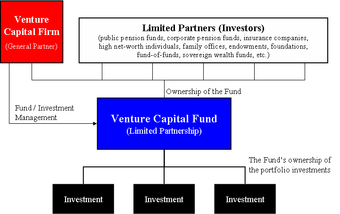
Structure of a Venture Capital Firm
The venture capital firm pools capital from investors and allocates it to venture efforts deemed worthy of investment.
Stages of Funding
Through informal and formal business networks, VC firms and entrepreneurs will meet to discuss the business plan and investment possibilities.There are different rounds of financing corresponding to different stages of a company’s development:
- Seed money round: The entrepreneur must convince the venture capitalist to fund their business vision. The VC firm is looking for a number of qualities including a solid business plan, an effective management team, high growth potential, and high target minimum returns. The VC firm will investigate into the technical and economic feasibility of the venture’s idea. If it is not directly feasible, but the investor sees potential, the investor will choose to invest some seed money for further investigation.
- Start-up: VC firms provide capital to early stage firms that need funding for marketing and product development. Organization of the company is formed, with finalization of the management team and establishment of an individual from the VC firm on the company’s board. The prototype product/idea is developed and tested. Market research for the idea is conducted, and the VC firm also monitors product feasibility and capability of the management. If at this stage the VC firm is not satisfied with the progress from market research, the VC firm may stop their funding and the venture will have to search for other sources of funding.
- Second-Round: Early-stage companies that are selling product but not yet turning a profit receive working capital.
- Expansion/Mezzanine financing: As the name suggests, VC firms provide expansion money for a newly profitable company.
- Bridge financing/exit of venture capitalist : Finally, the company is expected to either “go public” or be bought by a third-party company. The VC firm then exits by selling off its shareholdings of the company. The investor’s risk of losing the investment decreases as the company advances from one round to the next of this process.
14.1.3: Long-Term Debt
Long-term debt is a means of financing that allows firms access to capital without diluting equity; capital & interest is paid off over time.
Learning Objective
Discuss how long-term debt is used by companies
Key Points
- Debt financing takes the form of loans that must be repaid by the borrower over a specified period of time, usually with interest.
- Generally, debt financing is most appropriate for firms who are in the start-up phase or have progressed to the maturity phase. For young companies, debt financing usually takes the form of bank loans, while mature companies may issue bonds.
- When investors buy a corporate bond or the bank loans to a small business, they must have faith that the company will have the means to repay them. Riskier investments will require compensation for the lender in the form of higher interest rates.
- Bonds may be an attractive alternative to getting bank loans or issuing stock because it can have less restrictive loan terms and better interest rates than loans, and it doesn’t dilute equity or ownership as stock does. It also has considerable corporate tax advantages.
- Costs of debt financing include: bankruptcy costs (in the event of inability to cover payments to lenders) and increased uncertainty about future financing needs.
Key Terms
- bond
-
A documentary obligation to pay a sum or to perform a contract; a debenture.
- debt
-
Money that the borrowing entity owes or is required to pay to a lender.
Overview
In the most basic terms, debt financing takes the form of short-term or long-term loans that must be repaid over a specified period of time, usually with interest. Money is borrowed, and usually the borrower (debtor) gives the lender (creditor) a promissory note that obligates the debtor to pay back a certain defined amount at a particular and defined time in the future .

Bank loans as a means of financing
A promissory note dating to 1926 from the Imperial Bank of India, Rangoon, Burma for 20,000 Rupees, plus interest.
With debt financing, the creditor’s return is fixed as the agreed upon interest rate for the debt, which varies depending on the perceived riskiness of the debtor. Debt financing usually takes the form of bank loans or bonds.
Bonds
Bonds are a debt security under which the issuer owes the holders a debt. Depending on the terms of the bond, the bond issuer is obliged to pay the bondholders interest and/or to repay the principal (also known as nominal, par or face amount). Most corporate bonds are fixed-rate bonds, meaning that the interest rate stays the same until maturity. Some use floating rates to determine the exact interest rate paid to bond holders. The interest rate paid on these varies depending on some index, such as LIBOR. Other corporate bonds, called zero-coupons, make no regular interest payments at all, but investors still receive returns because these bonds are originally sold at a discount, and then are redeemed at par value upon maturity.
Interest Rate
The interest that the firm will pay ultimately comes down to one factor: at what rate will investors believe the bonds are a good investment? Riskier investments will require compensation for the lender in the form of higher interest rates. Indicators for riskiness can include individual credit histories (for a bank loan) or bond rating by a credit rating company (for corporate bonds). The difference in yield reflects the higher probability of default and liquidity and risk premium.
Capital Structure Theory
The actual effect of the firm’s capital structure on firm value is a contested topic in financial theory (see Miller Modigliani Theorem). From a tax perspective, debt financing may have some advantages over equity financing for both investors and the firm. Under a majority of taxation systems around the world, firms are subject to corporate tax and individuals to income tax, leading to double taxation of dividends, if the firm is financed through issuing stock.
For example, a firm that earns 100 dollars in profits in the U.S. would have to pay around 30 dollars in taxes. If it then distributes these profits to its owners as dividends, then the owners in turn pay taxes on this income, say 20 on the 70 dollars of dividends. The 100 dollars of profits turned into 50 dollars of investor income.
If, instead the firm finances with debt, then, assuming the firm owes 100 dollars of interest to investors, its profits are now 0. Investors now pay taxes on their interest income, say 30 dollars. This implies for 100 dollars of profits before taxes, investors got 70 dollars. The firm also benefits considerably, as interest payments can be deducted from the firm’s taxable income while dividends and share repurchases cannot be deducted.
It is also postulated that debt makes management more disciplined, forcing them to work harder to ensure that they will make enough to cover their interest payments. These benefits are applicable to both bonds and bank loans. However, costs of debt can outweigh these benefits, depending on the firm. In the event of inability to repay debts, firms go into bankruptcy which is a costly process in itself. Furthermore, the more debt a firm takes on, the more uncertainty it will have about future financing needs: if a firm is already taking on a considerable amount of debt today, where will it get financing for its operations in the future?
14.1.4: Common and Preferred Stock
Firms may raise capital by receiving funds from investors in exchange for equity stakes in the form of common and preferred stock.
Learning Objective
Differentiate the different types of preferred stock
Key Points
- Firms using equity financing gain financial capital from investors, in exchange for ownership stakes in the firm in the form of common and preferred stocks.
- The main advantage of equity financing is the lack of an obligation to pay back all investors in the event of poor company performance, while the main disadvantage is diminished control and business autonomy.
- In the event of liquidation and dividend payments, preferred stock has priority claims to assets. Common stockholders must wait until all preferred stockholders have been paid in full.
- In the event of bankruptcy, common stock investors receive any remaining funds after bondholders, creditors (including employees), and preferred stock holders are paid.
- Common stockholders often have voting rights, exercising some measure of control over company board elections and corporate policy, while preferred stockholders usually lack these rights.
- Preferred stock is divided into a number of sub-categories including: cumulative preferred stock, non-cumulative preferred stock, participating preferred stock, and convertible preferred stock.
Key Terms
- Preferred Stock
-
Stock with a dividend, usually fixed, that is paid out of profits before any dividend can be paid on common stock. It also has priority to common stock in liquidation.
- Common stock
-
Shares of an ownership interest in the equity of a corporation or other entity with limited liability. Holders of this type of stock are entitled to dividends. Importantly, the financial rights for holders of this type of stock are junior to preferred stock and liabilities.
Example
- If a company’s stock currently sells for 40 a share, expects to pay a dividend of 2 next year, is subject to flotation costs of 10%, and expects to maintain a growth rate of 10%, the cost of newly issued common stock = 2/[40(1-.10)] + .1 = 14.5%
Introduction: Equity Financing
Equity financing occurs when ownership stakes in a particular firm are exchanged for financial capital from investors. These investors may be all types of people, from friends and family of the business, to wealthy, “angel” investors, to venture capitalists. The main advantage of equity financing is that the business is not obligated to repay anything, since the individual investors are assuming a certain amount of risk in return for the possibility of making money in the future. However, because equity financing involves trading funds for ownership in the company, these new investors do gain some decision-making power in the company, and the managers lose some autonomy.
Common Stock and Preferred Stock
Typically, firms obtain their long-term sources of equity financing by issuing common and preferred stock. Holders of common stock (also be known as a “voting share” or an “ordinary share”) often have voting rights on corporate policy and have a say in electing the firm’s Board of Directors. They also receive dividend payments if the firm offers them. That being said, in the event of liquidation, preferred stock is considered more senior than common stock, in terms of rights awarded to particular investors. If one investor has preferred stock, while another holds common stock, that first individual has more rights to their share of assets, in the event of a liquidation. After bondholders, creditors (including employees), and preferred stock holders are paid their full share, common stock investors receive any funds that still remain. Thus, it is clear that common stock investors have the riskiest investment, often receiving nothing in the event of a bankruptcy.
Preferred stock is considered to be a form of equity security. It has properties of both an equity and a debt instrument, making it a “hybrid instrument”. Preferred stock generally has preference in receiving dividend payments and always has preference in asset claims during liquidation. That being said, holders of this type of stock usually do not have voting rights, while common stock holders do. Almost all preferred shares have a negotiated, fixed-dividend amount. The dividend is usually specified as a percentage of the par value, or as a fixed amount (for example, Pacific Gas & Electric 6% Series A Preferred). Sometimes, dividends on preferred shares may be negotiated as floating. This means that they may change according to a benchmark interest-rate index (such as LIBOR).
Types of Preferred Stock
In general, there are four different types of preferred stock: cumulative preferred stock, non-cumulative preferred stock, participating preferred stock, and convertible preferred stock. With cumulative preferred stock, If the dividend is not paid, it will accumulate for future payment. With non-cumulative preferred stock, dividends will not accumulate if they are unpaid. In other words, holders of this type of stock cannot make claims to forgone, past dividends. Convertible preferred stock are preferred issues which holders can exchange for a predetermined number of the company’s common-stock shares. This exchange may occur at any time the investor chooses, regardless of the market price of the common stock. It is a one-way deal, and an individual cannot convert the common stock back to preferred stock, if they have already exchanged their preferred stock with the company. The final type, participating preferred stock, are preferred issues that offer holders a set, specified dividend. These also offer investors the the opportunity to receive extra dividends if the company achieves predetermined financial goals. In the event of liquidation, holders of this last type of preferred stock are entitled to receive back the total amount they invested in the company, as well as the accumulated unpaid dividends, before any common stock holders are paid.
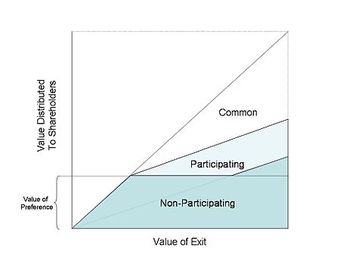
Participating Preferred vs. Non-Participating Preferred
This graph shows an example of a liquidation event, illustrating how assets will be divided up between common, participating preferred, and non-participating preferred stock holders. All preferred stockholders are paid first, before common stock holders. Participating preferred stockholders can “double dip”, and are entitled to both their money back, as well as the leftovers for common stock, proportionate to the amount of common stock for which their preferred stock can be converted into.
There are capital costs associated with equity financing, including accounting and legal costs, as well as underwriting and filing fees. For new issues of stocks, there are flotation costs that must be taken into consideration before choosing equity as a method of long-term financing. These can be established with the following formulas. Cost of preferred stock = Next dividend to be paid/[Current market value(1-flotation costs)]Cost of newly issued common stock = Next dividend to be paid/Current market value(1-flotation cost) + projected growth rate.
14.2: Venture Capital
14.2.1: Defining Venture Capital
Early-stage business ventures gain funding and guidance from venture capitalists in exchange for an equity stake in the firm.
Learning Objective
Describe how the venture capital process works
Key Points
- Venture capital is the financial capital provided to early-stage high-potential start-ups unable to acquire the necessary funding through conventional means.
- For venture capitalists, the high risk of investing is offset by the potential of high returns.
- Venture capitalists typically spread out their fund over a number of investments so that returns from successful investments will outweigh the losses from failed ventures.
- Venture capitalists take an active role in a company’s performance; guidance, expertise, and industry connections can be just as valuable as financial capital.
Key Terms
- Initial public offering
-
An initial public offering (IPO) or stock market launch is a type of public offering where shares of stock in a company are sold to the general public.
- venture capital
-
Money invested in an innovative enterprise in which both the potential for profit and the risk of loss are considerable.
Venture capital is a method of financing a business start-up in exchange for an equity stake in the firm. The risk of investment loss and the potential for future payout are both very high. As a shareholder, the venture capitalist’s return is dependent on the growth and profitability of the business. Return is earned when the business is sold to another owner or it “goes public” with an initial public offering (IPO). The venture capitalist can then “exit” by selling his shareholdings in the company.

Venture capital funds revolutionary social networking services
Facebook is one example of a entrepreneurial idea that benefited from venture capital financing. The Menlo Park-based firm has seen immense success since their launch in 2004. Unfortunately for Facebook’s venture capitalist investors (Accel Partners, Greylock Partners and Meritech Capital), the IPO has not performed as well as expected.
Due to their risky nature, most venture capital investments are done with pooled investment vehicles. Investors combine their financial contributions into one fund, which is then used to invest in a number of companies. This way, investors are diversifying their portfolio and spreading out risk. Venture capitalists are gambling that returns from successful investments will outweigh investments lost in failed ventures. Venture capitalists are selective in their investments. Innovative technology, growth potential and a well-developed business model are among the qualities they look for. Growth potential is the most important quality, given the high risk a VC firm assumes by investing. The priority for VC firms is high financial return and a successful exit within three to seven years.Venture funding is most suitable for businesses having large up-front capital requirements that cannot be financed by debt or other alternatives. These characteristics usually best fit companies in high-tech industries, which explains the venture capital boom of the late 1990s. The technology firms of Silicon Valley and Menlo Park were primarily funded by venture capital. These industries saw a surge in public interest that eventually generated large returns for VC firms.
A VC firm’s contributions often extend beyond financial funding. To increase the likelihood of high returns, it is in the venture capitalists’ interests to nurture their investments. Any guidance and expertise venture capitalists offer to start-up firms can be instrumental to success.
14.2.2: Advantages and Disadvantages of VC Financing
While VC financing provides the benefit of significant resources, costs include loss of ownership and autonomy.
Learning Objective
Discuss the advantages and disadvantages of using venture capital
Key Points
- With VC financing, companies can acquire large sums of capital that would not be possible through bank loans or other conventional methods.
- Venture capitalists provide expertise and industry connections that can be extremely valuable.
- Accounting and legal costs make securing a VC deal a difficult process. If a deal is secured, VC investors will be highly involved in deciding on the company’s strategic direction.
Key Term
- venture capital
-
Money invested in an innovative enterprise in which both the potential for profit and the risk of loss are considerable.

Weighing advantages and disadvantages
Pursuing venture capital financing may not be appropriate for most start-up companies. It is important to weigh the benefits of receiving abundant resources against the costs of losing autonomy and ownership.
Advantages: The primary advantage of venture capital financing is an ability for company expansion that would not be possible through bank loans or other methods. This is essential for start-ups with limited operating histories and high upfront costs. In addition, repayment of VC investors isn’t necessarily an obligation like it would be for a bank loan. Rather, investors are shouldering the investment risk because they believe in the company’s future success.
In addition to financial capital, venture capitalists provide valuable expertise, advice and industry connections. A stipulation of many VC deals includes appointing a venture capitalist as a member of the company’s board. This way, the VC firm has intimate involvement in the direction of the company.
Venture capital is also associated with job creation (accounting for 2% of US GDP), the knowledge economy, and used as a proxy measure of innovation within an economic sector or geography.
Disadvantages: Securing a VC deal can be a difficult process due to accounting and legal costs a firm must shoulder. The start-up company must also give up some ownership stake to the VC company investing in it. This results in a partial loss of autonomy that finds venture capitalists involved in decision-making processes. VC deals also come with stipulations and restrictions in composition of the start-up’s management team, employee salary and other factors. Furthermore, with the VC firm literally invested in the company’s success, all business operations will be under constant scrutiny. The loss of control varies depending on the terms of the VC deal.
14.2.3: IPOs
Initial public offerings are a primary and potentially lucrative means of exit from investment for venture capitalists.
Learning Objective
Describe the benefits and disadvantages of an IPO
Key Points
- An initial public offering is the first time a company’s stock is sold to the general public on a securities exchange, transforming the company from private to public. Though unpredictable and potentially costly, IPOs give benefits like increased access to financial markets and more capital.
- Venture capitalists gain both financial returns and professional reputation from successful IPOs.
- For venture-backed companies, their VC investors often expect the company to go public within a certain time frame so that they can sell or distribute their holdings of the company and exit the investment.
- Venture capitalists protect their ability to sell shares by contracting for registration rights prior to agreeing on funding the company. Demand rights allow the investors to initiate an IPO, while piggyback rights allow investors to sell when the company initiates an IPO.
- If the IPO market is weak, this threatens the venture capitalists’ chances of a successful exit. The VC investors may instead select a different method of exit, or they can wait and hope for the market to improve.
Key Terms
- Registration rights
-
A contractual agreement specifying conditions for registering shares of stock with the SEC prior to selling them on a security exchange.
- Initial public offering
-
An initial public offering (IPO) or stock market launch is a type of public offering where shares of stock in a company are sold to the general public.
Example
- For a recent example of a weak IPO market, we can look to online companies like Facebook and Zynga. Facebook’s IPO launch in May 2012 was highly anticipated but ended up under-performing, losing 47% of its original offering price as of August 2012. The online game developer Zynga’s IPO similarly fell flat despite high expectations. Falling values can put pressure on the VC investors to sell before they can lose any more of their returns.
An initial public offering (IPO), also known as a stock market launch, is the first time a private company’s shares are sold to the general public on a securities exchange. Allowing the general public to take up equity stakes in the company transforms it from being privately traded to publicly traded. If the company was venture-backed, the VC firms often gain their returns from IPO yields. Usually, the VC exits investments within a short time (1-3 years, normally) after the IPO is concluded either by distributing the shares to VC fund investors or selling them off on the market. Going public can also have benefits for the company, including:
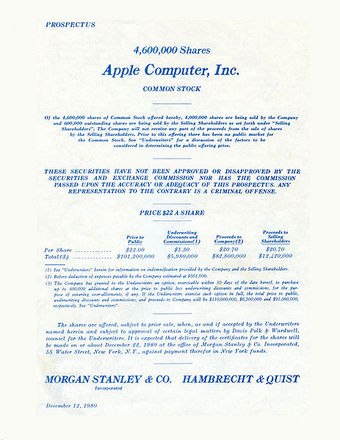
Apple Computers IPO Prospectus
The Initial Public Offering (IPO) Prospectus for Apple Computer Inc. in December 1980. A total of 5 million shares were offered to the public for $22 each. The total outstanding shares after the offering were 54,215,332. The company’s officers, directors and major shareholders held 32 million shares and the rest were held by the company for stock options plans and other needs. Apple’s valuation after the IPO was over $1 billion. (54 million shares at $22. )
- Increasing exposure, prestige, and public image
- Enlarging and diversifying equity base
- Enabling cheaper access to capital, which is particularly important for high growth companies
- Allowing owners of the company to cash in on their efforts in a very lucrative way (if the IPO is successful).
- Attracting and retaining better management and employees through liquid equity participation
IPOs are not without cost to the company. Disadvantages to completing an initial public offering, include:
- Legal, accounting and marketing costs associated with the process
- Requirement to disclose financial and business information
- Meaningful time, effort and attention required of senior management
- Risk that required funding will not be raised
- Public dissemination of information which may be useful to competitors, suppliers and customers.
Prior to agreeing to provide capital, venture capitalists contract for privileges including “registration rights”, which ensure their ability to sell shares into the public capital markets, thereby safeguarding their future returns. Prior to selling shares on the stock exchange, companies must register these shares with the Securities and Exchange Commission. The registration rights agreement between the company and the venture capitalists requires the company to register the offering of shares by venture capitalists under certain conditions.
These conditions may be in the form of “demand rights” or “piggyback rights”.
- Demand rights require the company itself to prepare, file and maintain a registration statement on behalf of the investors’ shares, so that investors can actually initiate a public offering and sell their shares.
- Piggyback rights require that the VC investors’ shareholdings are included in a company-initiated registration, so that the investors can sell their shares when the company initiates a public offering. The number of each type of demand or piggyback rights, the percentage of investors necessary to exercise these rights, allocation of expenses of registration, the minimum size of the offering, the scope of indemnification and the selection of underwriters and brokers are all areas of potential negotiation in the registration rights agreement.
14.3: Leasing
14.3.1: Capital Leases vs. Operating Leases
Capital leases and operating leases are two types of leases with different criteria.
Learning Objective
Distinguish between a capital and an operating lease
Key Points
- The finance company is the legal owner of the asset during duration of the lease. However the lessee has control over the asset providing them the benefits and risks of (economic) ownership.
- An operating lease is a lease whose term is short compared to the useful life of the asset or piece of equipment (an airliner, a ship, etc. ) being leased.
- Unlike a Financial Lease or Finance lease, at the end of the operating lease the title to the asset does not pass to the lessee, but remains with the lessor.
Key Term
- present value
-
Present value, also known as present discounted value, is the value on a given date of a payment or series of payments made at other times.
Capital lease
A capital lease (or finance lease) is a type of lease. It is a commercial arrangement where:
- the lessee (customer or borrower) will select an asset (equipment, vehicle, software);
- the lessor (finance company) will purchase that asset;
- the lessee will have use of that asset during the lease;
- the lessee will pay a series of rentals or installments for the use of that asset;
- the lessor will recover a large part or all of the cost of the asset plus earn interest from the rentals paid by the lessee;
- the lessee has the option to acquire ownership of the asset (e.g. paying the last rental, or bargain option purchase price);
The finance company is the legal owner of the asset during duration of the lease. However the lessee has control over the asset providing them the benefits and risks of (economic) ownership.
Under US accounting standards, a finance (capital) lease is a lease which meets at least one of the following criteria:
- ownership of the asset is transferred to the lessee at the end of the lease term;
- the lease contains a bargain purchase option to buy the equipment at less than fair market value;
- the lease term equals or exceeds 75% of the asset’s estimated useful life;
- the present value of the lease payments equals or exceeds 90% of the total original cost of the equipment.
Operating lease
An operating lease is a lease whose term is short compared to the useful life of the asset or piece of equipment (an airliner, a ship, etc.) being leased. An operating lease is commonly used to acquire equipment on a relatively short-term basis. Thus, for example, an aircraft which has an economic life of 25 years may be leased to an airline for 5 years on an operating lease.
The lessor leases the equipment to the lessee which pays periodically a rent. Operating lease is the smartest way for the outsourcing of industrial equipment. It allows the company not to use its equity in a investment that produces no direct added value, but to dedicate it to its core business and valuation.
Unlike a Financial Lease or Finance lease, at the end of the operating lease the title to the asset does not pass to the lessee, but remains with the lessor. Accordingly, at the end of an operating lease, the lessee has several possibilities:

Lease
Leasing is a good way to lower the costs of a company.
- Pursuit of the lease
- Return of the equipment
- Renewal of equipment
- Restoration of equipment
- Purchase of equipment at their market value
14.3.2: Impact of Leasing on the Income Statement
Leasing assets, both as lessee or lessor, has significant impacts on various financial statements.
Learning Objective
Identify the income statement implications of leasing an asset, both as lessor and lessee
Key Points
- Leasing is an alternative approach to buying an asset required for operation or selling an unused asset.
- The lessee, or the individual renting the asset, benefits from leasing through incurring lower costs (albeit consistently over time). The lessor benefits by procuring a return on a previous under-utilized investment.
- Capital leases usually transfer ownership of the leased item to the lessee at the end of the contract, while operating leases generally just represent utilization of the asset (and not eventual ownership).
- Capital leases and operating leases have different accounting implications for both the lessee and the lessor. Capital leases, due to the transfer of an asset, have a greater impact on the balance sheet.
Key Terms
- capital lease
-
A capital lease is usually quite long, perhaps even the entire duration of the life of the asset being leased. A capital lease has balance sheet implications, as the asset itself may be transferred at the end of the contract.
- operating lease
-
An operating lease is usually short compared to the life of the asset being leased, and does not result in a change of ownership at the end of the lease.
Leasing is an alternative approach to buying or selling a given asset or real estate location. The lessee will pay the lessor for the rights to utilize a given asset (i.e. the lessor is the owner of the asset, the lessee is renting it over a fixed time frame). For each respective organization, leasing will have significant impacts on financial statements during the accounting process. Understanding the accounting implications for each organization (lessee and lessor) is useful for accurate reporting on both the income statement and the balance sheet.
Capital and Operating Leases
In accounting, leases can be considered either operating leases or capital leases (also called financial leases). An operating lease is not reported as an asset or a liability (i.e. not represented on the balance sheet) and is expensed via the income statement as payments are incurred. A capital lease, on the other hand, is recorded as both asset and liability calculated as the present value of the cumulative rental payments (but never more than the overall fair market value of the underlying asset).
Capital Lease Criteria
When determining whether a lease is capital or operating, the following criteria are useful considerations:
- The lessee gains ownership of the asset at the conclusion of the lease
- The lessee is offered a bargain purchase contract at the end of the lease. This means the lessee can purchase the lease from the lessor at a price below the fair market price
- The life of the lease is equal to or greater than 75% of the economic life of the asset
- The present value of the minimum lease payments (MLP) is equal to or greater than 90% of the fair market value of leased property
If any one of these criteria are accurate in a given leasing contract, the lease is considered a capital lease and thus will impact the assets and liabilities of the balance sheet. Otherwise, it is seen as an expense and filed as an operating lease on the income statement.
Lessee Accounting
The lessee records rent expense (debit) over the lease term, and a credit to either cash or rent payable when on an operating lease. From an income statement perspective, the expense incurred is equivalent to the cumulative rent being paid over the reporting period.
With a capital lease, the lessee does not record rent as an expense. However, due to the classification of the leased asset, there are interest and depreciation alterations to be made via the income sheet when applicable. Over time, the depreciation and interest will equate to the value of the underlying rent payments.
From the lessee’s perspective, there are some situations where accountants must be aware of altercations to the asset and/or existing contract with the lessor:
- Improvements: If improvements are made, they should be capitalized and depreciated over the lease life. If the lessor gives the lessee a cash allowance for improvements, this is treated as a reduction of rent and amortized over the lease term.
- Percentage Rent: Some contracts have a percentage kick-back to the lessor in instances where sales reach a certain volume (common in retail leases). For example, the lessor decides that if the shop sells over $100,000, any sales past that point are subject to a 10% kick back to the owner of the property.
Lessor Accounting
For an operating lease – the ownership of the asset is maintained by the lessor and must be represented on the balance sheet as an asset. Rent revenue is credited with a corresponding debit to cash/cash receivables.
For a capital lease – the lessor debits the receivable account for the present value of the rents and credits any owned assets. Cash is debited upon payment while the receivable is credited, and unearned (interest) income is credited as well.
14.3.3: Advantages of Leasing
The main advantage of leasing lies in a business’ ability to attain assets without outlaying essential cash.
Learning Objective
Describe how a company can benefit from leasing its equipment
Key Points
- Leasing is a process by which a firm can obtain the use of a certain fixed asset for which it must pay a series of contractual, periodic, tax deductible payments.
- Capital assets may fluctuate in value. Leasing shifts risks to the lessor, but if the property market has shown steady growth over time, a business that depends on leased property is sacrificing capital gains.
- Depreciation of capital assets has different tax and financial reporting treatment from ordinary business expenses.
- Leasing may provide more flexibility to a business which expects to grow or move in the relatively short term, because a lessee is not usually obliged to renew a lease at the end of its term.
Key Term
- capital-intensive
-
Capital intensity is the term for the amount of fixed or real capital present in relation to other factors of production, especially labor.
Leasing Overview
Leasing is a process by which a firm obtains the use of a certain fixed asset for which it must pay a series of contractual, periodic, tax deductible payments.
In these arrangements there is a lessee and a lessor. The lessee is the receiver of the services or the assets under the lease contract while the lessor is the owner of the assets.
Advantages of Leasing
For businesses, leasing property may have significant financial benefits, which are outlined below:
- Leasing is less capital-intensive than purchasing, so if a business has constraints on its capital, it can grow more rapidly by leasing property than by purchasing property.
- Capital assets may fluctuate in value. Leasing shifts risks to the lessor, but if the property market has shown steady growth over time, a business that depends on leased property is sacrificing capital gains.
- Depreciation of capital assets has different tax and financial reporting treatment from ordinary business expenses. Lease payments are considered expenses rather than assets, which can be set off against revenue when calculating taxable profit at the end of the relevant tax accounting period.
- In some cases, a lease may be the only practical option; for example, a small business may wish to open a location in a large office building within tight location parameters.
- Leasing may provide more flexibility to a business which expects to grow or move in the relatively short term, because a lessee is not usually obliged to renew a lease at the end of its term.
14.4: The Role of Investment Banks in Financing
14.4.1: Underwriter
Investment bank underwriters help securities issuers lessen their risk in exchange for a premium.
Learning Objective
Explain the role of underwriters
Key Points
- Security issuers want to mitigate the risk of having an unsuccessful issue.
- Underwriters will buy the securities from the issuer and then sell it on the market. The underwriter aims to buy the securities below market price, and then sell them for a profit.
- Underwriters deal with both companies and government. The issuer could issue stocks, bonds, or any other type of security.
Key Terms
- issuer
-
The firm or government selling the security.
- security
-
proof of ownership of stocks, bonds, or other investment instruments.W
Underwriting refers to the process that a large financial service provider (bank, insurer, investment house) uses to assess the eligibility of a customer to receive their products (equity capital, insurance, mortgage, or credit). Underwriters exist in a number of different industries, and are primarily responsible for evaluating the risk of potential clients.
In investment banking, underwriters are best known for the role that they play in initial public offerings (IPOs). IPOs are when a company decides to sell equity on the stock market for the first time . They sell their own stock on the market and in the process, raise money through selling equity. However, investment banks are involved in the underwriting of all types of securities, not just stock.
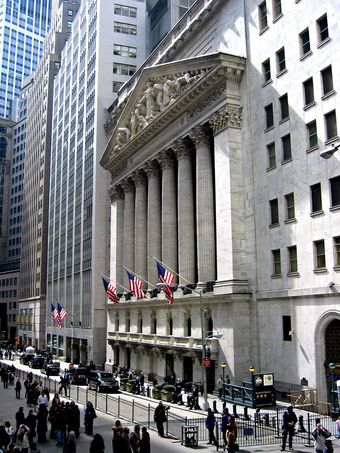
NYSE
Firms may issue an IPO on an exchange such as the New York Stock Exchange (NYSE). They sell their stock in exchange for cash.
The company needs to set a price for its stock; they want to set it high enough to raise as much money as possible but low enough that they will be able to sell their stock. Thus, there is a risk to the company in the offering of securities. For all types of securities, whether offered by companies or the government, there is a risk that the issuer may not be able to have a successful securities offering.
That is where the job of the security underwriter comes in. The underwriter offers to take on some of the risk of the offering in exchange for a premium. In essence, the underwriter buys the securities from the issuer and then turns around to sell the securities on the market. This means that the issuer gets cash up front. The issuer knows that it is probably not getting the full market value of the securities, but that’s okay because it no longer has the risk of having to find enough buyers to purchase the securities at a desirable price. The underwriting investment bank likes the deal because if it can sell the securities on the market at a higher price than it purchased them, it can make a profit.
There are sometimes multiple investment banks involved in the underwriting of a security. The details of the process may vary from deal to deal, but the fundamental job of the underwriter(s) is to take some of the issuer’s risk in exchange for a premium.
14.4.2: Market Maker
Market makers provide liquidity to securities markets by submitting both bids and asks on a security.
Learning Objective
Explain the role of market makers
Key Points
- Without sufficient liquidity, markets would become more inefficient because there may not be a buyer/seller to transact with, even at what should be the market price.
- Market-designated market makers provide liquidity by submitting both bids and asks on certain securities. This helps ensure transactions can occur at the market price.
- By submitting bids below ask prices, the market maker can make money.
- The difference between the highest bid and the lowest ask price is called the bid-ask spread.
Key Terms
- liquidity
-
Availability of cash over short term: ability to service short-term debt.
- bid-ask spread
-
the difference between the prices quoted for an immediate sale and an immediate purchase
- bid
-
The submitted price at which the trader is willing to buy.
- ask
-
The submitted price at which the trader is willing to sell.
- bid price
-
the amount offered by a buyer
The price of a stock is determined through a simple process of matching buyers and sellers. All those who want to sell the stock say the price at which they’re willing to sell a certain number of shares (the ask price). All those who want to buy say the maximum price they’re willing to pay for a certain number of shares (the bid). The difference between the highest bid and the lowest ask price is called the bid-ask spread . If the one person’s bid equals another’s ask price, they have found a price at which they’re both willing to do business, and the transaction occurs. The mutually agreeable price is then inputted as the stock price.

New York Spot Prices
The highest price someone is willing to pay (bid) for gold is $742.30 and the lowest someone is willing to accept (ask) is $743.30. There is a bid-ask spread of $1.10.
In major stock exchanges (such as the New York Stock Exchange) there are enough people who want to buy or sell at any given time that it’s generally easy to find someone to transact with if you’re making a bid/ask near the last price. This is called liquidity.
But what happens if there is no liquidity? Since there aren’t very many people looking to trade the stock, the highest bid may be significantly lower than the lowest ask price, so no transactions occur. A lack of liquidity is really bad for investors. If they don’t think they can buy/sell the stock when they need to, they will choose to just not deal with it.
That’s where a special type of trader comes in. They are the market makers. Market makers are a company or individual that quotes both an ask price and a bid. This helps to provide liquidity to the market, making the market more efficient. For this reason, many exchanges (such as the New York Stock Exchange and American Stock Exchange) have designated market makers for certain securities.
The financial reason why market makers do this is because the ask price that they submit will always be slightly higher than their bid. It is the bid-ask spread that provides the money-making opportunity. A bid-ask spread of even a cent can mean a huge profit when trading thousands of shares.
14.4.3: The Role of an Advisor
The advisory group of an investment bank is primarily concerned with facilitating the mergers and acquisitions of businesses.
Learning Objective
Define how investment banks act as advisors
Key Points
- Mergers and acquisitions (M&A) require an investment bank to bring the buyer and seller together and to help negotiate the deal.
- The advisor is hired by the client company to find a buyer/seller. The advisor pitches the deal to potential buyers/sellers using a pitch book, which contains all relevant financial information.
- The advisor also helps facilitate the deal which is incredible context because it must account for everything from financial projections to assets to brand names.
Key Term
- M&A
-
Mergers and acquisitions (M&A) are aspects of corporate strategy, corporate finance, and management dealing with the buying, selling, dividing, and combining of different companies and similar entities that can help an enterprise grow rapidly in its sector or location of origin, or a new field or new location, without creating a subsidiary, other child entity or using a joint venture.
Advisory Role
Investment banks also play the role of advisor to companies. They are not consultants, but are more like facilitators. The advisory group in an investment bank is often termed M&A.
M&A stands for “mergers and acquisitions”, which refers to the the buying, selling, dividing and combining of different firms. For example, if a company wants to sell of an unprofitable division, they will hire an investment bank to find a company that would want to buy it. Investment banks play a large role in facilitating M&A deals. The advisory group is charged with the task of helping buyers find sellers and vice versa, and then facilitating the deal.
Once the advisory group is hired by a company looking to sell itself to another, it will put together something called a pitch book. The pitch book contains all the relevant financial information about the company looking to get acquired. The investment bank then takes the pitch book to companies that it thinks might be interested in acquiring their client.
If the pitch is successful, the bank arranges the deal for the client. In order for the acquisition to take place, the two boards and leadership must be agree on the terms. This is often a very complex process because of the intricacies of the financial, functional, and organizational structures of both companies. There must be a plan for transferring everything from technology to debt to employees to titles, and the transaction must occur at a favorable price . If the negotiations are successful, the investment bank’s client will be acquired.

Pricewaterhouse Cooper
Pricewaterhouse Cooper got it’s name after the 1998 merger of Price Waterhouse and Coopers & Lybrand.
14.4.4: Agency
In its agency role, an investment bank is tasked with matching companies with investors.
Learning Objective
Define the different sources of capital financing
Key Points
- Many small and private companies cannot access traditional financial markets for capital, so they need to either take on debt or find other sources of financing. Investment banks help them find those other sources of capital.
- Common sources of financing are equity financing, mezzanine financing, and specialist financing (e.g., government loans).
- The investment banks match their clients to investors and then charge a fee for the service.
Key Term
- private
-
A company that is not publicly traded.
Investment banks are not confined solely to working with and making money on large, publicly traded companies. They also can be hired by private firms. A private firm might hire an investment bank for help with a merger or acquisition or for issuing an IPO (initial public offering of shares). A private firm might also hire an investment bank as a placement agent.
Suppose a firm does not want to be acquired and cannot (or does not want to get) good loans from banks. They still need to raise capital, but can’t access public markets, such as the stock market; they have to find different ways to raise capital. They hire a placement agent to act as an intermediary between them and investors. This allows them not only to connect with investors, but also allows them to focus on management, instead of finding investors.
Capital financing for private companies can come from a number of sources. Three of the main capital sources are:
- Equity financing: Private firms can sell some or all of their equity to investors. This is akin to selling off a portion of the ownership of the company. It may seem undesirable to sell a portion of the company’s ownership, but many firms (especially start-ups and growth companies) need to do so for immediate capital to fund future growth .
- Mezzanine capital: A subordinated debt or preferred equity instrument that represents a claim on a company’s assets, which is senior only to that of the common shares. Mezzanine financings can be structured either as debt (typically an unsecured and subordinated note) or preferred stock.
- Specialist financing: This could include things such as government loans or special grants that the company qualifies for.
Placement agents are most often compensated through fee arrangements based on the amount of money raised and supported by the fund or company they are representing.
14.5: Distributing Stock
14.5.1: Defining Spread
The spread is the difference between the prices for immediate purchase and sale of a stock, which is one measure of market liquidity.
Learning Objective
Describe the importance of spread in a stock transaction
Key Points
- The party that initiates the trade is the liquidity demander who pays the spread. The counterparty is the liquidity supplier who earns the spread.
- Liquidity suppliers use limit orders. A limit order is when the buyer waits until the stock reaches a designated price.
- The spread is one component of transaction cost, which along with brokerage fees, reflects the cost of making an instantaneous trade.
Key Terms
- liquidity
-
Availability of cash over short term: ability to service short-term debt.
- tender offer
-
an invitation to shareholders of a corporation to exchange their shares in return for a monetary buy-out
Concept
The bid–offer spread for securities is the difference between the prices quoted for an immediate sale (offer) and an immediate purchase (bid). The size of the bid-offer spread in a security is one measure of the liquidity of the market and size of the transaction cost. If the spread is 0 then the security is a frictionless asset.

Signals from dividend policy may give clues about stocks.
The spread measures the cost of executing an instant trade.
Liquidity
The trader initiating the transaction is said to demand liquidity, and the other party (counterparty) to the transaction supplies liquidity. Liquidity demanders place market orders and liquidity suppliers place limit orders.
Limit Order
A limit order is an order to buy or sell a stock at a specific price or better. A buy limit order can only be executed at the limit price or lower, and a sell limit order can only be executed at the limit price or higher. A limit order is not guaranteed to execute. A limit order can only be filled if the stock’s market price reaches the limit price. While limit orders do not guarantee execution, they help ensure that an investor does not pay more than a pre-determined price for a stock.
Example
If the current bid price for the EUR/USD currency pair is 1.5760 and the current offer price is 1.5763, this means that currently you can sell the EUR/USD at 1.5760 and buy at 1.5763. The difference between those prices (3 pips) is the spread.
For a round trip (a purchase and sale together), the liquidity demander pays the spread and the liquidity supplier earns the spread. In some markets such as NASDAQ, dealers supply liquidity. However, on most exchanges, such as the Australian Securities Exchange, there are no designated liquidity suppliers, and liquidity is supplied by other traders. On these exchanges, and even on NASDAQ, institutions and individuals can supply liquidity by placing limit orders.
Transaction Costs
The bid–offer spread is an accepted measure of liquidity costs in exchange traded securities and commodities. On any standardized exchange, two elements comprise almost all of the transaction cost—brokerage fees and bid-offer spreads. Under competitive conditions, the bid-offer spread measures the cost of making transactions without delay.
14.5.2: Pricing a Security
The price of a security is the market determination of the value of the underlying asset.
Learning Objective
Differentiate the different methods of pricing a security
Key Points
- Several methods are used to determine the value of a company including Present Value, Comparable Company Analysis, and Net Asset Value. The goal of each of these methods is to determine the worth of a potential investment in the company.
- Financial analysis of this sort determines what investors are willing to pay for a given security because it is what they think the security is worth.
- If most investors think a stock is worth a lot, or will be in the future, they buy it and this demand drives price up. The opposite occurs if investors are not confident about the stock. Therefore, stock price reflects investor expectations.
Key Term
- security
-
proof of ownership of stocks, bonds, or other investment instruments.W
Concept
The price of a security reflects the value of the asset underlying it. Therefore, the market price for a security indicates the consensus value placed on its asset by all the buyers and sellers in the market. It is the result of the valuation of the asset .
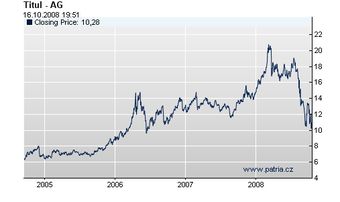
Price
Price fluctuates depending on how the market values the security.
Valuation
In finance, valuation is the process of estimating what something is worth. There are different valuation methods. The choice of which method to use depends in part on what kind of security one is valuing. For instance, some financial instruments such as options are valued using mathematical models which take several variables into account. The price of stocks, on the other hand, depends on the value of the company. There are several methods used to value the company itself.
Present Value
This method estimates the value of an asset based on its expected future cash flows, which are discounted to the present. This concept of discounting future money is commonly known as the time value of money. The time value of money says that if you have an asset that matures in one year and pays $1 at that time, it is worth less than $1 today. This is because if you have a dollar today, you can do all kinds of things with it: invest it, use it to buy something you want, or pay back a debt. On the other hand, if you have to wait a year to get your dollar, you miss out on all these opportunities. Those missed opportunities are called the opportunity cost. Therefore, money you get in the future needs to be reduced to approximate the opportunity cost. The size of the discount is based on the opportunity cost of capital and it is expressed as a percentage. This percentage is the discount rate.
For a valuation using the discounted cash flow method, one first estimates the future cash flows from the investment and then estimates a reasonable discount rate after considering the riskiness of those cash flows and interest rates in the capital markets. Then one makes a calculation to compute the present value of the future cash flows.
Comparable Company Analysis
This method determines the value of a firm by observing the prices of similar companies that sold in the market. Those sales could be shares of stock or sales of entire firms. The observed prices serve as valuation benchmarks. From the prices, one calculates price multiples such as the price-to-earnings or price-to-book value ratios. Next, one or more price multiples are used to value the firm. For example, the average price-to-earnings multiple of the guideline companies is applied to the subject firm’s earnings to estimate its value.
Net Asset Value
The third common method of estimating the value of a company looks to the assets and liabilities of the business. At a minimum, a solvent company could shut down operations, sell off the assets, and pay the creditors. Any cash that would remain establishes a floor value for the company. This method is known as the net asset value. Normally, the discounted cash flows of a well-performing company exceed this floor value. However, some companies are “worth more dead than alive,” such as weakly performing companies that own many tangible assets. This method can also be used to value heterogeneous portfolios of investments, as well as non-profit companies for which discounted cash flow analysis is not relevant.
Financial Analysis
Financial professionals make their own estimates of the valuations of assets or liabilities that they are interested in. Their calculations are of various kinds including analyses of companies that focus on
- price-to-book
- price-to-earnings
- price-to-cash-flow
- present value calculations
All of these approaches may be thought of as creating estimates of value that compete for credibility with the prevailing stock or bond prices, and may result in buying or selling by market participants.
Price and Valuation
Investors use valuation methods to estimate what a company is worth, but the price of a stock on the market usually does not rest at the book-value of the company. Typically there will be people who are either optimistic about the company–because they anticipate that it will be worth more in the future than it is in the present–or pessimistic–because they think it will do worse in the future. Optimists will buy more of the stock and drive the price up, while pessimists will sell and drive it down. Therefore, a stock’s market price also takes into account expectations for the future performance of the company.
14.5.3: Shelf Registration
Shelf registration is a type of public offering in which the issuer is allowed to offer several types of securities in a single prospectus.
Learning Objective
Describe the self registration process
Key Points
- A company can file a shelf registration statement with a prospectus that offers different classes of securities. It can then sell all, none, or some of the classes at any time.
- Regulators generally grant shelf registration to companies that are reliable. They also require a statement of material changes in business since the prospectus was filed before each security is actually sold.
- Shelf registration can be used by a company as a strategy to quickly sell securities for funds when market conditions become favorable.
Key Term
- prospectus
-
A document that describes a proposed endeavor (venture, undertaking) such as a literary work (which one proposes to write).
Definition
Shelf registration or shelf offering is a type of public offering where certain issuers are allowed to offer and sell securities to the public without a separate prospectus for each act of offering. Instead, there is a single prospectus for multiple, undefined future offerings. The prospectus (often as part of a registration statement) may be used to offer securities for up to several years after its publication .

Shelf Registration
Some of the securities in the prospectus can be “shelved,” and sold later.
Application
A company can file a shelf registration statement with, for instance, a prospectus for 100,000,000 shares, $1,000,000,000 face value of bonds, $500,000,000 dollar face value of convertible bonds, $50,000,000 Series A warrants, and $50,000,000 Series B warrants. These five different classes or series of securities are offered in a single document. The company may offer to sell all of them, none of them, or any part of some class. It can sell 30,000,000 shares at one time and another 50,000,000 a year later. In that case, it will then have 20,000,000 unissued shares covered by the shelf prospectus.
Material Changes in Business
Before each offering and sale is actually made, the company must file a relatively short statement regarding material changes in its business and finances since the shelf prospectus was filed.
Regulation
Shelf registration is usually available to companies deemed reliable by the securities regulation authority in the relevant country. Shelf offerings, due to their purposefully time-constrained nature, are examined far less rigorously by those authorities, compared to standard public offerings.
Strategy
Shelf registration is a registration of a new issue which can be prepared up to two years in advance, so that the issue can be offered quickly as soon as funds are needed or market conditions are favorable. By using shelf registration, the firm can fulfill all registration-related procedures beforehand and go to market quickly when conditions become more favorable.
Firms often use universal shelf filings and choose between debt and equity offerings based on the prevailing relative market conditions.
14.6: Comparing Public and Private Financing
14.6.1: Advantages of Public Financing
The main advantage in seeking public financing is that it offers a larger pool of funding for the company than private financing alone.
Learning Objective
Discuss why a company may want to go public
Key Points
- The magnitude of funding available from public financing is its chief advantage.
- An initial public offering is when a private company converts to a public company by selling shares of its stock publicly.
- A company can sell further shares of stock in secondary offerings.
- A company can also sell debt, in the form of bonds, in public exchanges.
Key Term
- security
-
proof of ownership of stocks, bonds, or other investment instruments.W
Public Company Definition
A publicly traded company is a limited liability company that offers its securities for sale to the general public, typically through a stock exchange, or through market makers operating over the counter markets. .

Public Financing
Public financing offers immediate access to large amounts of funding.
Main Advantage of Public Financing
Usually, security of a publicly traded company is owned by many investors while the shares of a privately held company are owned by relatively few shareholders. Therefore, publicly traded companies are able to raise funds and capital through the sale (in the primary or secondary market) of their securities, whether debt or equity, to a wide range of buyers. This is the reason publicly traded corporations are important; prior to their existence, it was very difficult to obtain large amounts of capital for private enterprises. The magnitude of funding available from public financing is its chief advantage.
Advantages from Initial Public Offering
New companies, which are typically small, tend to be privately held. After a number of years, if a company has grown significantly and is profitable or has promising prospects, there is often an initial public offering, which converts the privately held company into a publicly traded company.
Through this process, a private company transforms into a public company. Initial public offerings are used by companies to raise expansion capital, to monetize the investments of early private investors, and to become publicly traded enterprises.
When a company lists its securities on a public exchange, the money paid by the investing public for the newly issued shares goes directly to the company (primary offering) as well as to any early private investors who opt to sell all or a portion of their holdings (secondary offering) as part of the larger IPO. An IPO, therefore, allows a company to tap into a wide pool of potential investors to provide itself with capital for future growth, repayment of debt, or working capital. A company selling common shares is never required to repay the capital to its public investors.
An IPO accords several benefits to the previously private company:
- Enlarging and diversifying equity base
- Enabling cheaper access to capital
- Increasing exposure, prestige, and public image
- Attracting and retaining better management and employees through liquid equity participation
- Facilitating acquisitions (potentially in return for shares of stock)
- Creating multiple financing opportunities, such as equity, convertible debt, and cheaper bank loans
Advantages from Follow-On Offering
Once a company is listed, it is able to issue additional common shares in a number of different ways, one of which is the follow-on offering. This method provides capital for various corporate purposes through the issuance of equity without incurring any debt. This ability to quickly raise potentially large amounts of capital from the marketplace is a key reason many companies seek to go public.
14.6.2: Advantages of Private Financing
Private financing can enhance a firm’s capital structure, save on costs, and improve managerial incentive alignment.
Learning Objective
Describe why a company may want to go private
Key Points
- One advantage of private financing is that private investors may infuse the company with more capital than was available to it from public financing.
- Private financing also saves on administrative costs of being a publicly traded company.
- Private financing can improve incentives for management, and increase investor involvement.
Key Terms
- incentive
-
Something that motivates, rouses, or encourages.
- Stock
-
The capital raised by a company through the issue of shares. The total of shares held by an individual shareholder.
- investor
-
A person who invests money in order to make a profit.
Definition
In countries with public trading markets, a privately held business is generally taken to mean one whose ownership shares or interests are not publicly traded. Often, privately held companies are owned by the company founders or their families and heirs or by a small group of investors. Sometimes employees also hold shares of private companies. Most small businesses are privately held.

Private financing
Private financing can offer advantages over public.
Going Private
Though most companies start out privately held, there are situations in which a publicly traded company becomes privately acquired. This means that a small group of investors purchases all outstanding shares of the company. The company is then privately financed. This transition it known as “going private. “
Advantages
There are several advantages to private financing:
- Increased capital: Sometimes going private results in a significant injection of capital, because the investors are willing to buy the company’s stock at a higher price than it is trading on the market. They are willing to pay more in order to privately control the firm.
- Administrative costs: It is possible for the company to save administrative costs. Being a publicly traded company entails administrative costs, such as annual reports, registration with regulating bodies, and communicating with shareholders. A privately financed company does not have these costs.
- Managerial incentives: In many instances it is the management which takes over and privately controls the company. In this case, they have a more immediate incentive to improve the company’s performance, because they are investors as well.
- Investor involvement: A publicly traded company’s shareholders are a large, anonymous, and mostly uninformed group. They do not typically know the business, much less the daily operations, of the company and are not in a good position to be productively involved with it. Private investors, on the other hand, can offer expert knowledge, and direct oversight of the company in a way that can benefit performance.
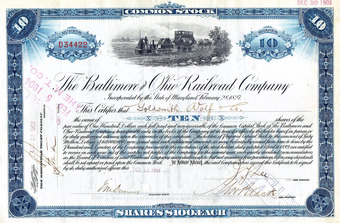
1903 stock certificate of the Baltimore and Ohio Railroad
Normally stocks are traded publicly, except in the instance of private stocks, which are only offered and traded by internal stakeholders such as founders, employees, etc.
14.6.3: Types of Private Financing Deals: Going Private and Leveraged Buyouts
LBOs use debt to secure an acquisition and the acquired assets service the debt.
Learning Objective
Define a leveraged buyout
Key Points
- The acquiring party borrows money in addition to using its own funds to meet the purchase price of the target. LBOs can also occur to public companies, such as in public to private (PtP) transactions.
- The term typically applies to a deal in which a financial sponsor acquires a company. In this instance, the sponsor uses debt to increase its return on equity.
- LBOs are appealing to the acquiring company because debt typically carries a lower cost of capital than equity, which means that by employing more debt, the acquiring party magnifies returns.
Key Terms
- insolvency
-
The condition of being insolvent; the state or condition of a person who is insolvent; the condition of one who is unable to pay his debts as they fall due, or in the usual course of trade and business; as, a merchant’s insolvency.
- overleveraged
-
Subject to excessive leverage
- leverage
-
The use of borrowed funds with a contractually determined return to increase the ability of a business to invest and earn an expected higher return (usually at high risk).
Definition of Leveraged Buyout
A leveraged buyout (LBO) is an acquisition (usually of a company, but it can also be single assets like a real estate) where the purchase price is financed through a combination of equity and debt, and in which the cash flows or assets of the target are used to secure and repay the debt . As the debt usually has a lower cost of capital than the equity, the returns on the equity increase with the increasing debt. The debt thus effectively serves as a lever to increase returns, which explains the origin of the term leveraged buyout (LBO).

Financing deal
An LBO is a type of financing deal.
Forms of LBOs
LBOs are a very common occurrence in today’s Mergers and Aquisitions environment. The term LBO is usually employed when a financial sponsor acquires a company. However, many corporate transactions are part-funded by bank debt, and thus also effectively representing an LBO. LBOs can have many different forms, such as Management Buyout (MBO), Management Buy-in (MBI), and secondary buyout and tertiary buyout, among others. They can occur in growth situations, restructuring situations, and insolvencies just like in companies with stable performance. LBOs mostly occur in private companies, but can also be employed with public companies (in a so-called PtP transaction, Public to Private).
Common Cause of LBOs
As financial sponsors increase their returns by employing a very high leverage (i.e., a high ratio of debt to equity), they have an incentive to employ as much debt as possible to finance an acquisition. This has, in many cases, led to situations in which companies were “overleveraged”, meaning that they did not generate sufficient cash flows to service their debt. In turn, this then led to insolvency or to debt-to-equity swaps, in which the equity owners lose control over the business and the debt providers assume the equity.
Characteristics
LBOs have become attractive, as they usually represent a win-win situation for the financial sponsor and the banks: The financial sponsor can increase the returns on his equity by employing the leverage; banks can make substantially higher margins when supporting the financing of LBOs as compared to usual corporate lending. The amount of debt banks which are willing to provide and support an LBO varies greatly and depends on the quality of the asset to be acquired–stability of cash flows, history, growth prospects, and hard assets; the amount of equity supplied by the financial sponsor; and the history and experience of the financial sponsor.
Debt Ratio
For companies with very stable and secured cash flows, debt volumes of up to 100% of the purchase price have been provided. In situations of “normal” companies with normal business risks, debt of 40–60% of the purchase price are normal figures. The debt ratios that are possible also vary significantly between the regions and industries of the target. Depending on the size and purchase price of the acquisition, the debt is provided in different tranches:
- Senior debt: This debt is secured with the assets of the target company and has the lowest interest margin
- Junior debt: This debt usually has no securities and bears a higher interest margin
